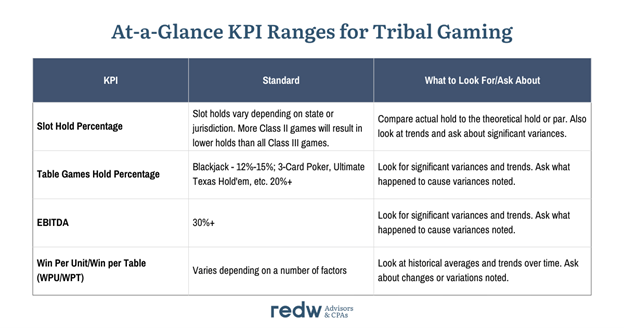Kevin Huddleston, CPA, CFF, CGMA
Those involved in tribal gaming don’t need accounting degrees to interpret casino KPIs effectively — they just need the right context and confidence to ask the right questions.
Is your tribe’s 5.5 percent slot hold good or bad? When the monthly net win is $1 million, does that mean you’re succeeding or falling behind? How do you know with confidence?
If you’re like most non-accountants, you might feel that familiar knot in your stomach — not because you don’t know your business, but because numbers without context can be meaningless. And in tribal gaming, where every dollar supports community programs, scholarship funds, and economic development, getting the story behind the numbers right isn’t just important, it’s essential.
For example, if I told you someone succeeded 30 percent of the time at something, you might shrug and think it’s unimpressive. But if I added that this person is a Major League Baseball hitter, suddenly that 30 percent — a .300 batting average — sounds exceptional. Context makes all the difference.
Why context is everything
Numbers by themselves are just that — numbers. Interpreting them requires context. Comparing figures to your property’s past performance, to industry benchmarks, and to your own internal goals all help you determine whether a statistic reflects something positive or requires attention.
You don’t have to be an accountant to glean insights from financial or operational statistics. You just need a bit of background and the confidence to ask the right questions.
Understanding key casino KPIs
Let’s break down some common casino KPIs with the context you need.
 Slot hold percentage
Slot hold percentage
What is it?
The slot hold percentage is your net win divided by the total coin-in (the amount played).
Why is context important?
Hold rates can vary widely — often depending on the mix of Class II and Class III games and volume.
- Class III games tend to have higher holds than Class II.
- Theoretical hold (manufacturer prediction) and actual hold (actual performance) should align over time.
A few things to watch for:
- Hold can change month-to-month (for example, after a big jackpot).
- Compare your current hold to historical averages for your property.
- There are actually two ways to calculate hold:
- Statistical hold (as reported by the slot system): calculates every dollar in and out, regardless of source.
- Accounting hold (as used on financial statements): adjusts for free play and progressive liabilities.
- Tip: When someone quotes a hold percentage, always ask which type it is!
Table game hold
What is it?
Net win divided by the “drop” — the total amount exchanged for chips.
What’s typical?
- Blackjack: 12 to 15 percent, depending on the number of decks and whether it is hand dealt or uses a shuffler
- Other House-banked card games (like mini-baccarat, 3-card poker, Ultimate Texas Hold’em): 20 percent or more
- Roulette: 15 to 25 percent
- Craps: 12 to 17 percent
How should you read it?
Compare to your property’s own averages. Month-to-month swings are normal. Look for significant changes and ask why they happened.
Win per unit (WPU) and win per table (WPT)
How is it calculated?
Net win divided by the number of machines/tables divided by the number of days in the period.
Important context:
- There’s no universal benchmark. Local factors and volume matter:
- Rural casinos may have lower WPU/WPT.
- Properties near state lines with less local competition may run higher.
- The most critical point is to look for trends over time, not just single numbers.
- If your casino adds or removes slots/tables, this number will shift. Understand what’s causing any changes — don’t just assume performance is up or down.
EBITDA percentage
What does it mean?
EBITDA (Earnings Before Interest, Depreciation, and Amortization) as a percentage of revenue measures how effectively management is controlling expenses.
What’s good?
- Generally, you want this number to be in the 30 percent or more range.
- Tracking percentage trends over time is more important than any one month’s snapshot.
- Ensure free play is being treated as a reduction of revenue, not just as an expense, so you’re comparing apples to apples.
- If you see this figure drop, ask what’s changed in your operations.
Bringing it all together
Numbers, without context, can’t tell you if you’re doing well or need to improve. But with the right perspective, they become powerful tools for decision-making. Don’t be afraid to ask questions — whether it’s about which “hold” is being used, how a KPI is changing, or why the numbers look different from last month.
If you’re not sure what your reports are telling you, reach out to your favorite “numbers nerd.” We love to help translate statistics into stories!
Remember: Context and curiosity are your best tools for making sense of your casino’s numbers. The more you ask and learn, the more meaningful — and helpful — these figures will become.




